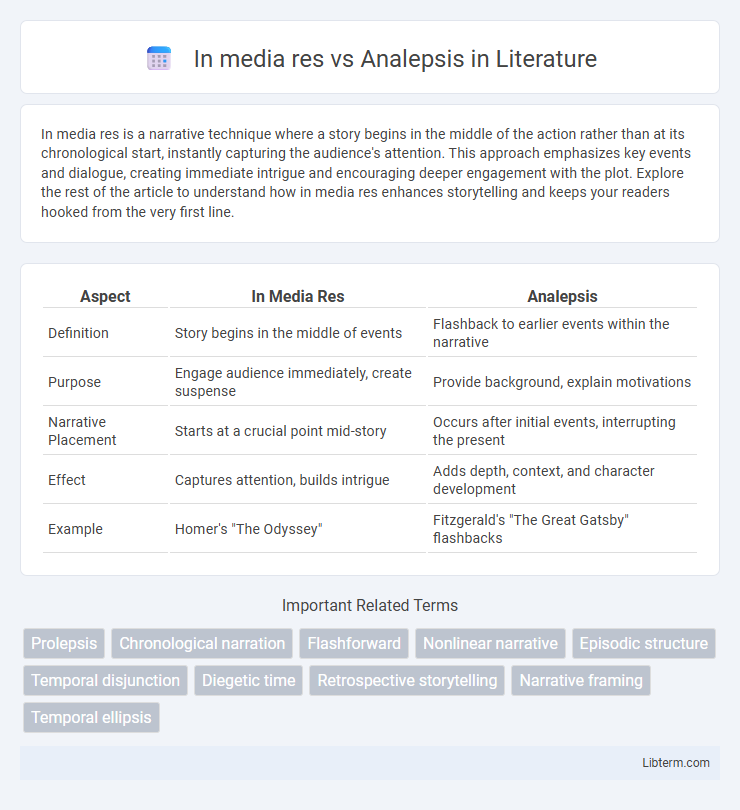In media res is a narrative technique where a story begins in the middle of the action rather than at its chronological start, instantly capturing the audience's attention. This approach emphasizes key events and dialogue, creating immediate intrigue and encouraging deeper engagement with the plot. Explore the rest of the article to understand how in media res enhances storytelling and keeps your readers hooked from the very first line.
Table of Comparison
| Aspect | In Media Res | Analepsis |
|---|---|---|
| Definition | Story begins in the middle of events | Flashback to earlier events within the narrative |
| Purpose | Engage audience immediately, create suspense | Provide background, explain motivations |
| Narrative Placement | Starts at a crucial point mid-story | Occurs after initial events, interrupting the present |
| Effect | Captures attention, builds intrigue | Adds depth, context, and character development |
| Example | Homer's "The Odyssey" | Fitzgerald's "The Great Gatsby" flashbacks |
Understanding In Media Res: Definition and Purpose
In media res is a narrative technique where a story begins in the middle of the action, bypassing traditional exposition to immediately engage the audience. This approach creates immediate tension and curiosity by dropping readers directly into a conflict or pivotal moment, compelling them to piece together prior events through dialogue or flashbacks. The purpose of in media res is to enhance suspense and immersion, making the storyline more dynamic and emotionally impactful from the outset.
Analepsis Explained: Diving into Flashbacks
Analepsis, commonly known as a flashback, disrupts the chronological flow by inserting past events into the current narrative, providing essential background and character motivation. This technique enriches storytelling by revealing key plot details and emotional context that shape the present storyline. Unlike in media res, which starts amidst the action, analepsis specifically looks backward, creating depth and complexity through retrospective insight.
Structural Differences Between In Media Res and Analepsis
In media res begins a narrative in the middle of the action, immediately immersing the audience without prior context, while analepsis, or flashback, interrupts the chronological flow to provide background information or character history. Structurally, in media res relies on subsequent storytelling techniques like dialogue or flashbacks to fill in missing events, whereas analepsis is embedded within a linear narrative to deepen understanding of preceding occurrences. The tension in in media res arises from the initial disorientation and the gradual revelation of previous events, contrasting with analepsis, which momentarily shifts the timeline to a past moment before returning to the present narrative.
Narrative Impact: How Both Techniques Shape Storytelling
In media res immerses readers immediately in the action, creating urgency and engagement by starting the narrative at a crucial point, often leaving out initial context to be revealed later. Analepsis, or flashback, provides valuable background information that deepens character development and context, enriching the narrative by unveiling past events that influence the present story. Both techniques manipulate temporal structure to enhance suspense and emotional impact, with in media res driving momentum forward and analepsis adding layers of meaning through retrospective insight.
Examples of In Media Res in Modern Literature and Film
In media res is a narrative technique that begins a story in the middle of the action, often used in modern literature and film to create immediate engagement. Prominent examples include Quentin Tarantino's *Pulp Fiction* (1994), which starts with a tense conversation before revealing earlier events through flashbacks. Another notable instance is Margaret Atwood's *The Handmaid's Tale* (1985), where the plot unfolds in the midst of the dystopian regime, with past events gradually disclosed.
Iconic Uses of Analepsis in Storytelling
Analepsis, or flashback, is a powerful narrative device used to reveal crucial backstory that enriches character motivation and plot depth, exemplified by films like "Citizen Kane" and "The Godfather Part II". Unlike in media res, which plunges the audience directly into the middle of the action, analepsis strategically disrupts chronological order to provide context and illuminate past events that shape present circumstances. Iconic uses of analepsis often serve as pivotal storytelling moments, enhancing emotional resonance and thematic complexity by revisiting critical plot points through character memories or narrative retrospection.
Reader Engagement: Contrasting Effects on Audience Immersion
In media res plunges readers directly into the action, creating immediate suspense and heightened curiosity, which intensifies audience immersion by forcing them to piece together context as the story progresses. Analepsis, or flashbacks, enrich narrative depth by gradually revealing past events, providing clarity and emotional resonance that deepen reader understanding and engagement over time. The contrasting effects lie in the pacing and information flow: in media res stimulates active interpretation and urgency, while analepsis fosters reflective absorption and narrative coherence.
When to Use In Media Res vs Analepsis
In media res is effective for gripping audiences by starting a narrative in the middle of action, creating immediate suspense and engagement, often used in thrillers or action genres. Analepsis, or flashback, is ideal for revealing crucial backstory and character motivations after establishing the present timeline, enriching the plot and deepening emotional resonance. Choose in media res to immerse viewers instantly, while analepsis works best for layered storytelling and contextual clarity.
Common Mistakes in Employing Nonlinear Narratives
Common mistakes when employing nonlinear narratives like in media res and analepsis include confusing timelines that disrupt reader engagement and coherence. Writers often overuse flashbacks or start in the middle of the action without clear contextual anchors, causing narrative disorientation. Effective nonlinear storytelling requires careful balance to maintain clarity while enhancing thematic depth and pacing.
Tips for Mastering Complex Narrative Structures
Mastering complex narrative structures involves understanding key techniques like in media res and analepsis to enhance storytelling clarity and engagement. Employ in media res to drop readers directly into action, then use analepsis strategically for flashbacks that reveal essential background without disrupting the plot's momentum. Balancing these methods requires careful planning of pacing, clear temporal markers, and consistent character development to prevent confusion and maintain narrative cohesion.
In media res Infographic

 libterm.com
libterm.com